10 Things to Make with Chamomile
Chamomile (Matricaria chamomilla) is an easy to grow garden flower that’s often used in skin care products such as lotion, soap, salves, and other items for itchy, irritated, or sensitive skin. Internally, the tea is calming, soothes upset stomachs and anxiety, and promotes relaxation.

Chamomile is so easy to start from seed, so if you have a garden spot, I encourage you to try growing some.
Years ago, I grew a small patch of chamomile in my garden by simply sprinkling seed over the dirt and raking it in, and it has reliably self-seeded and spread each year since.
If you’re allergic to ragweed, there’s a slight chance you may have an allergic reaction to chamomile too, so be sure to spot test any new chamomile product on your skin and avoid if it triggers itching or allergy.
Free Chamomile Printable!
Before we get into the ways to use chamomile – here’s a handy printable all about growing and using German chamomile!

Feel free to share with friends and especially the younger generation, helping to carry on the legacy of using what grows around you. ?
More free plant printables are scattered throughout the site, including:
- Dandelion Printable in my article: 12+ Things to Make with Dandelion Flowers
- Purple Dead Nettle Printable in my article: 9+ Things to Make with Purple Dead Nettle
- Violet Printable in my article: 10+ Things to Make with Violets
(You may print copies of my free printables to share with scout groups, garden clubs, etc. Just make sure the copyright information stays attached at the bottom and do not sell them for personal gain. Links WILL change as printables get updated over time – please link to this page when sharing, not the exact printable to avoid broken links.)
What to Do with Chamomile Flowers
Here are ten pretty and useful ways to use chamomile flowers!
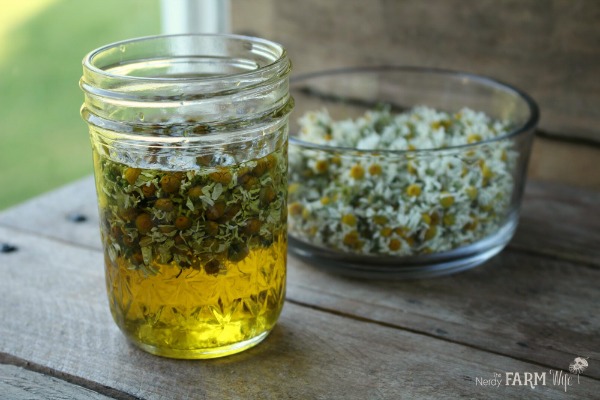
1. Chamomile Infused Oil
Chamomile infused oil can be used to make lotion bars, lip balm, soap, deodorant, body butter, and more!
To make the infused oil:
- Fill a small canning or other heatproof jar about half way with dried chamomile blossoms. (It’s fine if some of the leaves and stems get in too.)
- Pour oil over the flowers until the jar is almost full, leaving a little bit of room for expansion and shaking.
- If you’re going to use the oil for soap, try infusing olive oil. Sunflower is a great choice for lip balms, lotions, etc. or you could choose something like rice bran, apricot kernel, or sweet almond oil. (I love using the organic oils from Mountain Rose Herbs for my skincare products.)
- At this point, you can infuse the slow way (my favorite method), or if you’re in a hurry, the quicker way. You’ll also need to use the quick method if you’re infusing something that’s solid at room temperature, such as coconut oil.
To infuse the slow way, just put a lid on your jar of herbs and oils and tuck them away in a cabinet for at least four weeks, shaking occasionally.
For a quicker infusion, keep the jar uncovered, set it down into a saucepan containing a few inches of water and let this heat over a low burner for around two hours. Remove from heat and use a portion of it right away for a recipe. Then top the jar off with fresh oil, cover it with a lid and let it infuse the slow way for a few weeks longer, for use in future projects.
Once the oil is infused to your satisfaction, it can be strained and stored for around 9 months to a year, or until you’re ready to use it.

2. Chamomile & Sweet Orange Deodorant
I made this deodorant using chamomile infused coconut oil, and scented it with sweet orange and frankincense essential oils.
You’ll also need:
- shea or mango butter
- beeswax
- arrowroot powder
- white kaolin clay (or baking soda)
Find the full recipe at:

3. Chamomile Lip Balm (with printable labels)
These lip balms are perfect for smoothing over rough, dry, or chapped lips. I also have some labels that you can print out for your lip balms!
You’ll need:
- chamomile infused oil
- castor oil (or more infused oil)
- shea or mango butter
- beeswax (or candelilla wax for vegan version)
Find the recipe & the printable labels at:
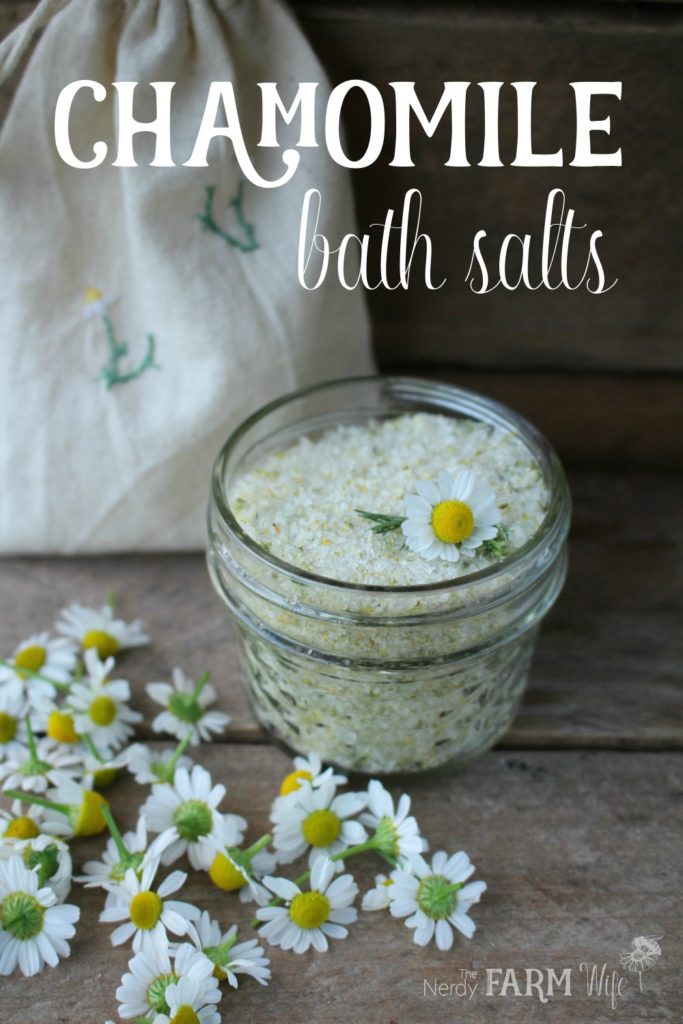
4. Bath Salts or Soaks
It’s easy to make pretty chamomile colored and scented bath salt – you just need fresh chamomile flowers and any type of salt.
If I’m using the finished salt to make bath bombs (as in the next project), I use sea salt. For bath soaks, Epsom salt is a good choice too.
For the full recipe, visit:
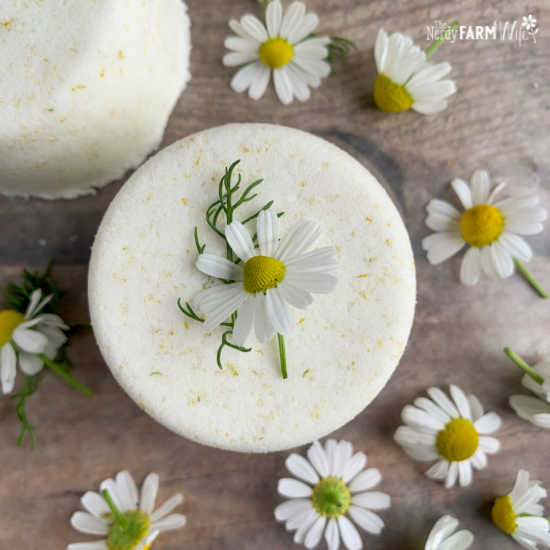
5. Chamomile Bath Bombs
Use the chamomile salt from above to make these bath bombs.
Ingredients needed:
- 1 1/2 cups baking soda
- 3/4 cup citric acid
- 1/2 cup chamomile salt
- 2 tbsp chamomile infused coconut or other oil
- 20 to 25 drops lavender essential oil, optional
- Witch hazel in a spray bottle
- 1/3 or 1/2 cup measuring cup for a mold
How to make:
- Stir together the baking soda, citric acid, and chamomile salt together in a medium mixing bowl, working out any clumps with your fingers.
- In a separate bowl, combine the infused chamomile coconut oil (melted) with the lavender essential oil, if using.
- Slowly drizzle the melted oil into the combined dry ingredients while stirring with a whisk, then use your fingers to break up any remaining clumps.
- Pick up a handful of mixture and squeeze it into a ball shape with your hand.
- If it crumbles, spray 2 or 3 spritzes of witch hazel into the mixture while stirring, then check again.
- When the mixture holds together easily without crumbling, it’s ready to turn into bath bombs!
- Fill the measuring cup with the bath bomb mixture, pressing firmly as you pack it in, then turn out the bath bomb from the measuring cup and onto a sheet of wax paper.
- Allow the bath bombs to air-dry for several hours, then wrap in airtight packaging.
(For more natural bath soak and bath bomb ideas, be sure to also check out my Natural Bath Care Package!)
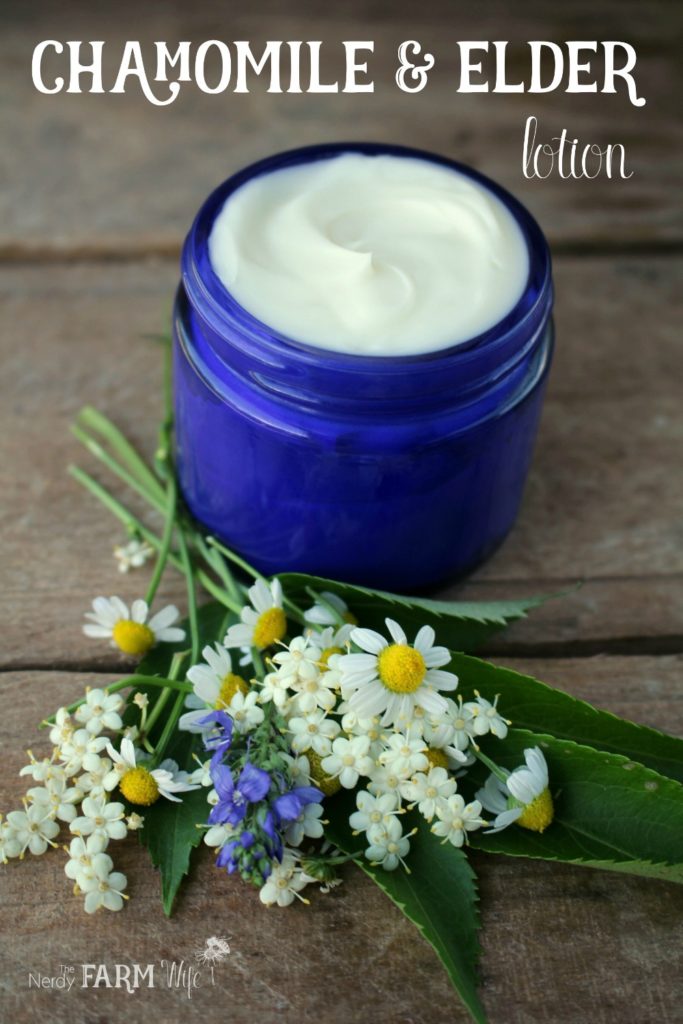
6. Use the Flowers in Lotion Recipes
Chamomile infused oil can replace plain oil in lotion and cream recipes.
For this recipe, I also infused the oil with elderflowers and marshmallow root for their ability to soothe inflammation and irritation.
It’s a gentle lotion, perfect for those with extra sensitive skin.
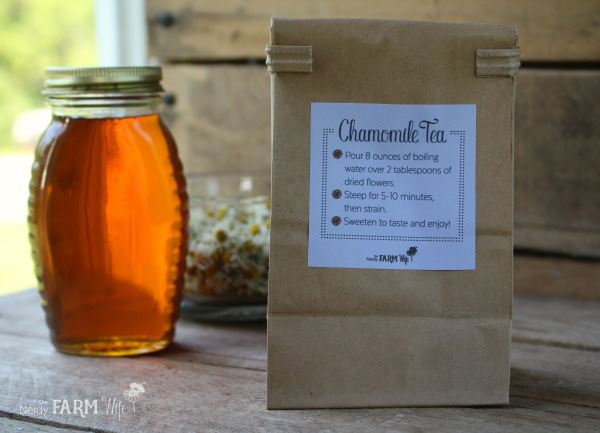
7. Chamomile Tea + Labels
While you can buy chamomile tea bags from the store, chamomile tea is so easy to make at home too!
Just gather fresh flower heads and spread them out in a single layer on a clean dish towel until completely dry, then package in brown paper bags or another container.
Here’s how you make a cup of chamomile tea:
- Pour 8 ounces simmering hot water over 2 tablespoons dried chamomile flowers.
- Steep for 5 to 10 minutes, then strain.
- Sweeten to taste with honey and enjoy!
Be sure not to steep chamomile for too long, since it can get bitter with extended steeping time.
I’ve also provided some printable labels, so you’ll always have the directions to make the tea handy.
You can find more information and those printable labels in my article:
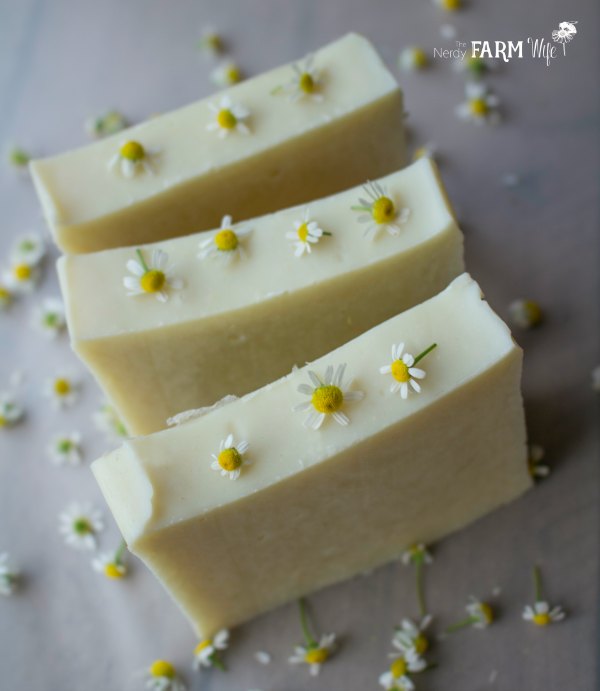
8. Chamomile Soap
Chamomile infused oil can be used for soapmaking too!
Try infusing your olive or coconut oil with chamomile, then use it to make a batch of soap. Depending on the strength of your infusion, it can add a soft yellow tone to the soap.
Virtually all herbs and flowers lose their scent during the soapmaking process, but chamomile is the rare exception in that you’ll sometimes find a light hint of it remaining in the finished soap.
Here are some soap recipes to explore:
- Chamomile “Almost” Castile Soap – super mild, perfect for sensitive skin, made from just olive oil and castor oil
- Chamomile Tea & Honey Shampoo Bars – this soap can be used from head to toe
- Chamomile Carrot Soap – one of my favorite combinations! Find it over at Homespun Seasonal Living.
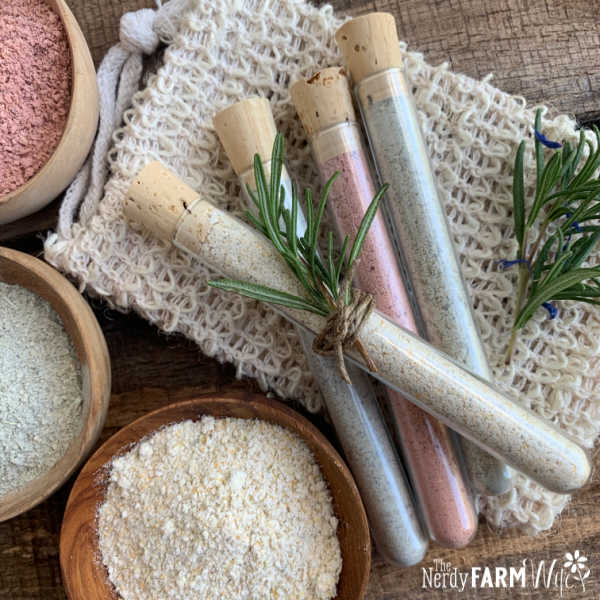
9. Chamomile Rose Cleansing Grains
This is one of four cleansing grain recipes from my print book, The Big Book of Homemade Products for Your Skin, Health & Home. (Shown in the photo above as the tube of pink cleansing grains, in the middle.)
These flower packed cleansing grains gently exfoliate your skin, leaving it feeling soft and smooth.
Ingredients needed:
- 2 tbsp (14 g) rolled oats
- 1/2 tbsp (4 g) milk powder (cow, goat, coconut)
- 1/2 tbsp (0.5 g) dried rose petals
- 1/2 tbsp (0.5 g) dried chamomile flowers
- 1/2 tsp rose kaolin clay
To make: Grind all of the ingredients together in a coffee grinder until finely powdered. Store in an airtight container to keep fresh and dry.
To use: Splash your face with comfortably warm water. Place one or two teaspoons of cleansing grains into your hand and mix with warm water or another liquid (aloe, yogurt, witch hazel, or milk) to form a paste. Gently rub over your face and throat. Rinse well with comfortably warm water and follow with your favorite light moisturizer, if desired. You could also use as a mask, by leaving on your skin for 5 to 10 minutes, before rinsing off.
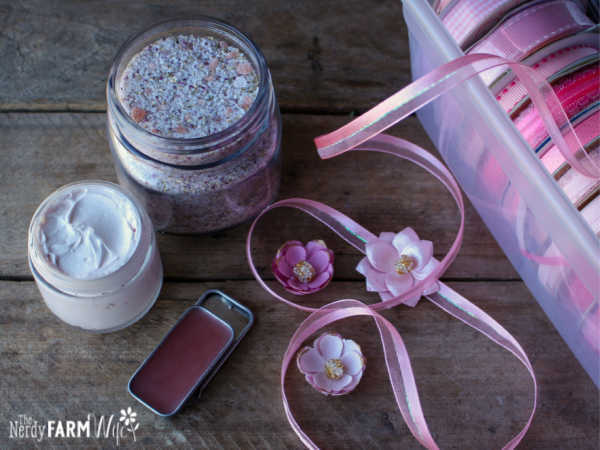
10. Chamomile Rose Lip Balm
This lip balm recipe is from my article, DIY Rose & Chamomile Gift Set. (That article also includes recipes for the whipped hand cream and bath soak, also shown in the photo above.)
Ingredients needed:
- 3.5 tbsp (35 g) oil infused with chamomile (& rose petals if possible)
- 0.5 tbsp (5 g) castor oil (or more infused oil)
- 1 tbsp (14 g) shea or mango butter
- 1 tbsp (10 g) beeswax pastilles (or grated, pressed tightly in the spoon)
- pinch of alkanet root (for color)
- optional: 2 to 3 drops peppermint or sweet orange essential oil
This recipe fills about 7 or 8 lip balm slider tins.
To make: Melt the oils, butter, beeswax, and alkanet root together in a heatproof jar. Once melted, remove from heat and let cool a few minutes. Add a few drops of essential oil, if desired. Pour into slider tins or small round half-ounce tins. If you want to make this lip balm in tubes instead of tins, decrease the oil by around 1 tablespoon.
References & Further Reading
Cech, Richo. Making Plant Medicine. Williams, OR: Horizon Herbs, 2000. Print.
Sebai, Hichem, et al. Antidiarrheal and antioxidant activities of chamomile (Matricaria recutita L.) decoction extract in rats. Journal of Ethnopharmacology. 2014 Mar 14;152(2):327-32.
Srivastava, Janmejai K., et al. Chamomile: A herbal medicine of the past with bright future. Molecular Medicine Report. 2010 Nov 1; 3(6): 895–901.


I have chamomile tea bags. Can they be infused in oil ? And if so, how many bags/oil?
Hi Tara! Yes, you can use chamomile tea bags to infuse in oil. It depends on the size of the tea bags and how filled they are, but a good starting point is about 2 or 3 tea bags for every 1/2 cup of oil.